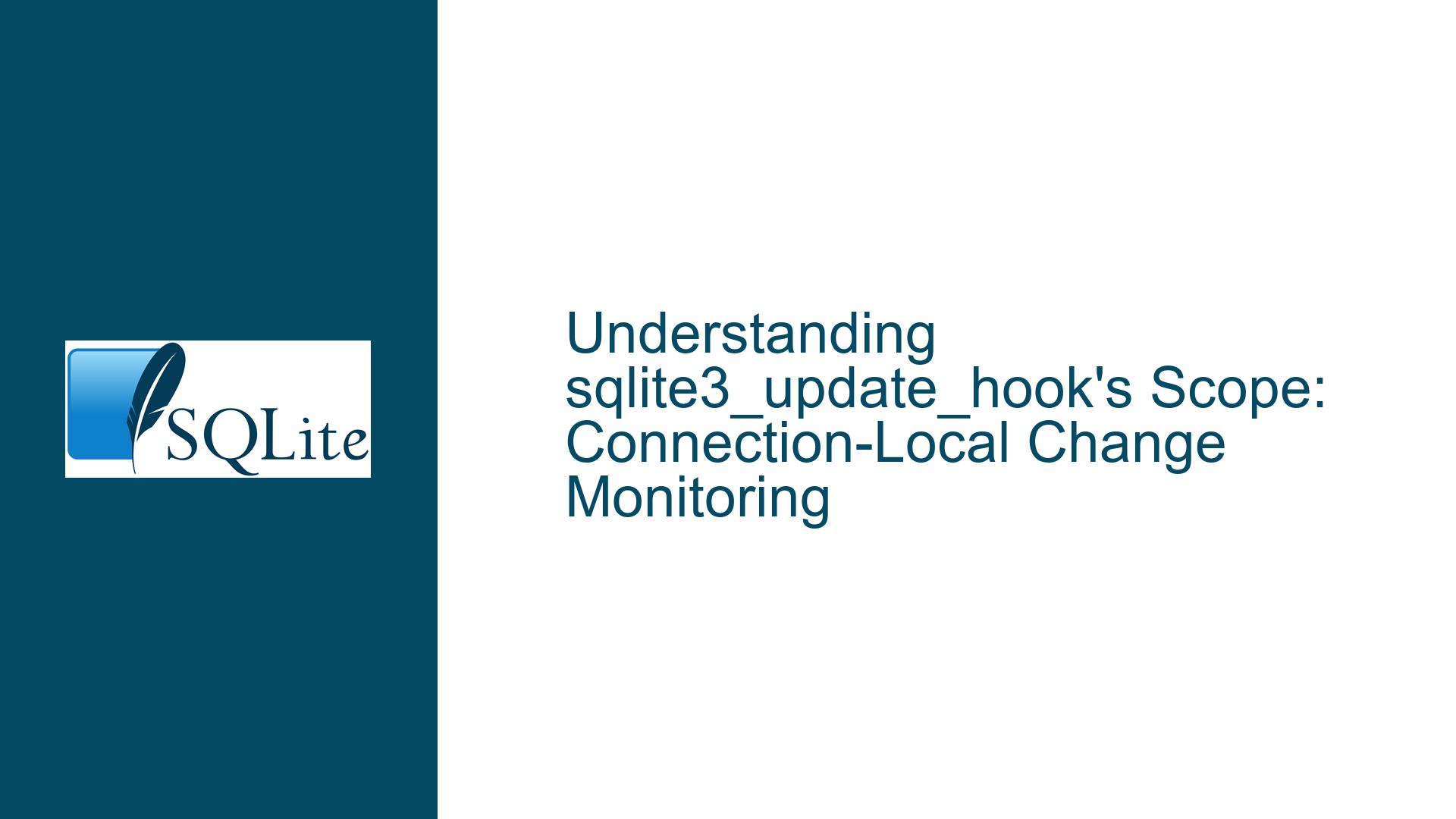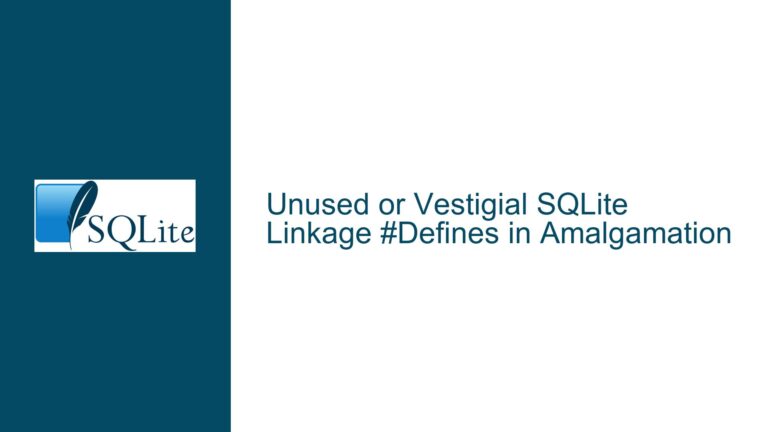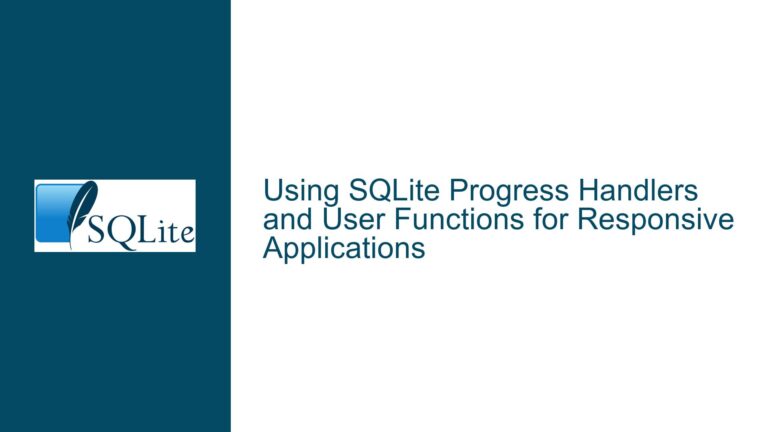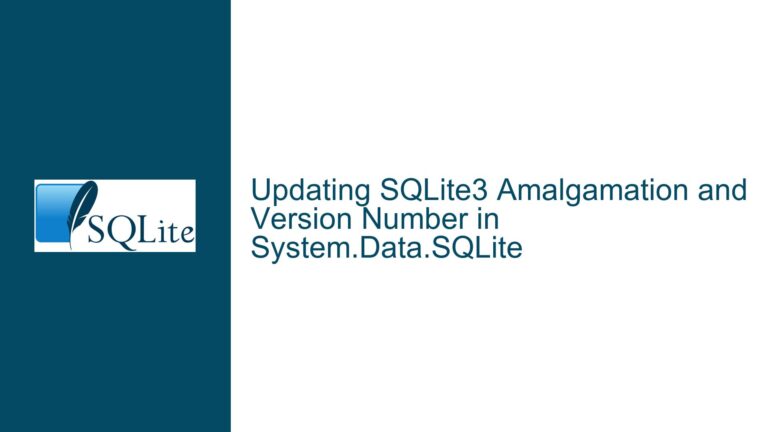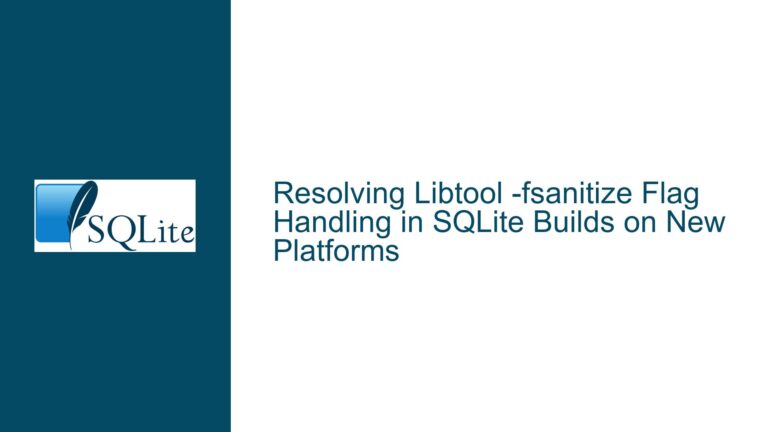sqlite3_update_hook’s Scope: Connection-Local Change Monitoring
sqlite3_update_hook Monitors Only Local Connection Changes
The sqlite3_update_hook is a callback mechanism in SQLite that allows applications to monitor changes to a database. Its behavior is often misunderstood due to ambiguities in documentation and assumptions about database event propagation. At its core, this function registers a callback that fires when changes are made to the database via the specific connection on which the hook is registered. It does not report changes made through other connections – even within the same process – nor changes from external processes.
Key Characteristics of sqlite3_update_hook
Connection-Specific Triggering:
The hook is tied to the lifetime and activity of a singlesqlite3*connection object. When a write operation (INSERT, UPDATE, DELETE) is executed through this connection, the callback is invoked. Changes made via other connections – including those opened in the same process – are ignored.
Example:- Connection A registers an update hook.
- Connection B modifies a table.
- Connection A’s hook will not fire.
Granularity of Notifications:
The hook provides details about the affected database name (e.g., "main"), table name, operation type (INSERT/UPDATE/DELETE), and rowid. However, it lacks context about transaction boundaries or the specific data modified.Exclusions and Edge Cases:
- System table changes (e.g.,
sqlite_master) do not trigger the hook. - Virtual tables may bypass the hook depending on their implementation.
- Transactions rolled back via
ROLLBACKwill not retroactively clear already-fired hooks.
- System table changes (e.g.,
Why This Behavior Is Counterintuitive
Many developers expect the hook to act as a global event listener due to:
- Ambiguity in Documentation: The official documentation states the hook is "registered with the database connection" but does not explicitly clarify that it monitors only that connection.
- Analogy to Client-Server Databases: In systems like PostgreSQL or MySQL, triggers or notification systems often propagate events across sessions. SQLite’s embedded, in-process nature breaks this expectation.
- UI/Application Development Patterns: Modern frameworks (e.g., .NET’s
ObservableCollection) provide in-process event broadcasting, leading developers to assume SQLite offers similar cross-connection visibility.
Architectural Constraints
SQLite’s design as a serverless, file-based database imposes inherent limitations:
- No Inter-Process Communication (IPC): There is no built-in mechanism for processes to notify each other of changes.
- Connection Isolation: Each connection operates independently, with its own transaction state and cache.
Common Misconceptions About sqlite3_update_hook’s Reach
Myth 1: "The Hook Tracks All Changes in the Current Process"
Reality: Each connection maintains its own set of hooks. A change made via Connection B will not trigger a hook registered on Connection A, even if both are in the same process. This isolation prevents race conditions and simplifies transaction management but limits visibility.
Myth 2: "External Process Changes Are Detectable via the Hook"
Reality: SQLite has no IPC layer. When another process modifies the database file, the current process’s connections are unaware unless they explicitly check for changes (e.g., via PRAGMA data_version).
Myth 3: "Hooks Can Replace Database Triggers"
Reality: Unlike triggers, which are database-side and persist across connections, hooks are client-side and transient. They are best suited for debugging or logging, not enforcing business logic.
Why These Myths Persist
- Documentation Gaps: The official docs do not emphasize the connection-local nature of hooks.
- Overlap with Trigger Semantics: Developers familiar with SQL triggers assume hooks behave similarly but at the application layer.
- Confusion with WAL Mode: Write-Ahead Logging (WAL) allows concurrent readers/writers, creating a false impression that hooks might detect cross-connection changes.
Implementing Cross-Connection or Cross-Process Change Tracking
Solution 1: Use PRAGMA data_version for Cross-Connection Detection
SQLite provides PRAGMA data_version, a globally incrementing counter that changes when any connection modifies the database. Unlike the update hook, this works across connections but not across processes.
Implementation Steps:
- Before executing a query, store the current
data_version:PRAGMA data_version; - After the query, check if
data_versionhas changed. If so, poll for specific changes.
Limitations:
- Does not indicate what changed – only that something changed.
- Requires polling, which adds overhead.
Solution 2: Leverage the user_version for Application-Specific Versioning
PRAGMA user_version is a user-controlled integer that persists across sessions. Applications can manually increment it to signal schema or data changes.
Workflow:
- After modifying critical data, update the
user_version:PRAGMA user_version = user_version + 1; - Poll this value periodically to detect changes.
Drawbacks:
- Requires manual management.
- Not tied to specific transactions or operations.
Solution 3: File System Monitoring for Cross-Process Changes
When external processes modify the database, file system events (e.g., inotify on Linux, ReadDirectoryChangesW on Windows) can notify the application.
Steps:
- Monitor the database file’s last-modified timestamp or size.
- On detecting a change, reopen the database or check
PRAGMA data_version.
Caveats:
- File system events are unreliable for WAL-mode databases.
- May trigger false positives (e.g., journal file updates).
Solution 4: Custom Middleware for Centralized Event Handling
Introduce an abstraction layer that routes all database operations through a single connection or service. This centralizes change tracking but adds complexity.
Example Architecture:
- A dedicated thread or process handles all write operations.
- The middleware broadcasts change events to other components.
Solution 5: Combine sqlite3_update_hook with data_version Polling
For hybrid scenarios where both local and remote changes matter:
- Use
sqlite3_update_hookto track local changes. - Periodically poll
PRAGMA data_versionto detect external changes. - On
data_versionchange, invalidate caches or refresh UI elements.
Optimization:
- Reduce polling frequency using timers or idle callbacks.
- Cache query results and compare hashes to avoid unnecessary refreshes.
Final Recommendations
- For Single-Connection Apps: Rely on
sqlite3_update_hookfor lightweight change tracking. - Multi-Connection Apps: Use
PRAGMA data_versionwith periodic checks. - Cross-Process Scenarios: Implement file monitoring or a centralized service.
By understanding SQLite’s design constraints and leveraging pragmas judiciously, developers can build responsive applications despite the absence of built-in global notifications.
